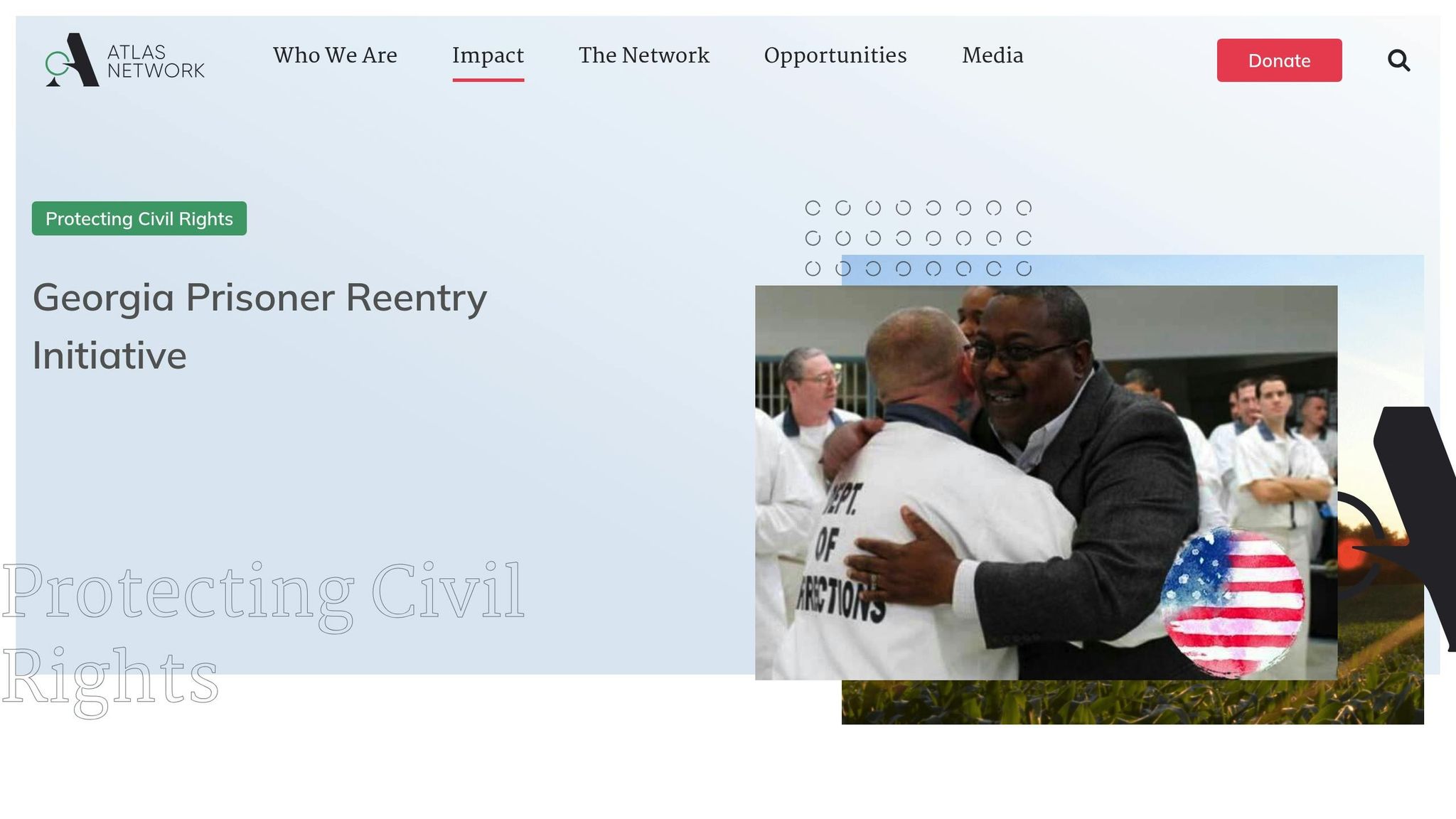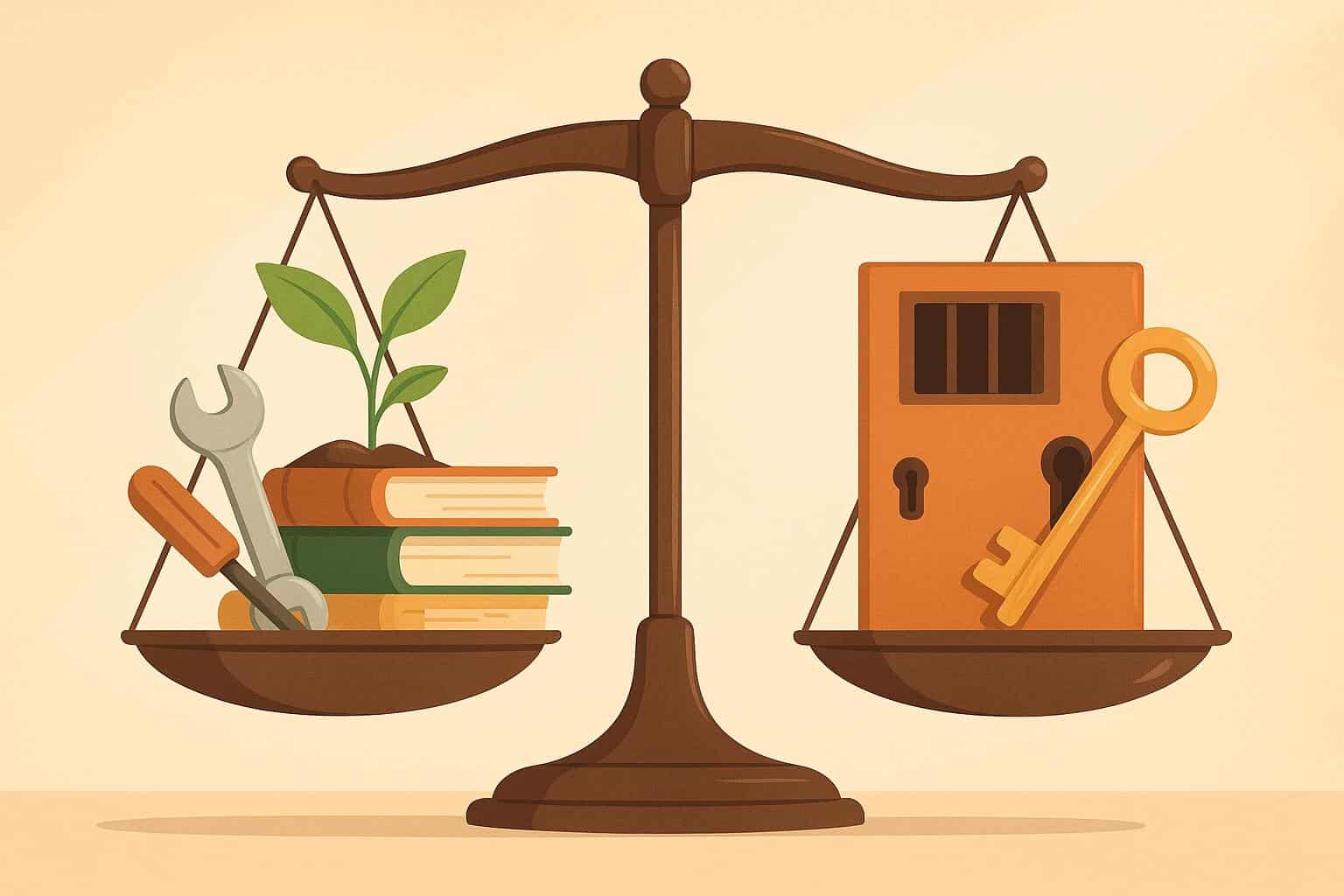Resource allocation in Georgia’s prison system directly affects recidivism rates. When resources are used wisely, individuals are more likely to reintegrate into society successfully. Here’s what matters most:
- Access to Programs: Educational, job training, mental health, and substance abuse programs reduce reoffending.
- Post-Release Support: Housing, employment, and community services are critical for reintegration.
- Data-Driven Decisions: Tracking program success ensures resources go where they’re needed most.
- Addressing Inequality: Rural areas often lack services, creating barriers to rehabilitation.
How Can We Reduce Recidivism Rates? – Jail & Prison Insider
Current Repeat Offense Rates in Georgia
Repeat offense rates in Georgia highlight the challenges posed by limited resources within the state’s prison system.
Georgia Repeat Offense Statistics
Georgia faces a persistent issue with recidivism, as many individuals reoffend soon after their release. A lack of access to rehabilitation programs and reentry services contributes to this cycle. Strengthening these support systems is crucial for helping individuals reintegrate successfully. Without proper intervention, this ongoing trend not only hampers personal recovery but also places a heavy financial burden on the state.
Cost of Repeat Offenses
The expenses tied to repeat offenses – such as incarceration, legal proceedings, and law enforcement – put significant pressure on state budgets. Addressing recidivism could help improve the efficiency of public spending. Beyond financial costs, these repeated offenses also impact the broader community, as described below.
Community Impact of Repeat Offenses
The effects of high recidivism ripple through communities, disrupting families, threatening public safety, and weakening neighborhood ties. These cycles of incarceration also affect local economies, emphasizing the need for targeted efforts to build stronger, safer, and more resilient communities.
Resource Distribution Problems
Georgia’s prison system struggles to allocate resources effectively, creating challenges in reducing recidivism and supporting rehabilitation.
Uneven Access to Services
Rural prisons often lack the rehabilitation programs available in urban areas. According to Georgia Prisoners’ Speak, this imbalance limits access to mental health and substance abuse treatments, which are critical for successful rehabilitation. These gaps in services highlight deeper systemic issues that need attention.
Lack of Data-Driven Planning
Without reliable tracking systems, decision-makers can’t measure program success, address regional needs, or evaluate the overall impact on recidivism. This lack of data makes it harder to identify and fix resource disparities, further complicating efforts to support those in the system.
Barriers to Reentry
Many facilities fall short in providing essential post-release support like housing, job placement, and healthcare. Without structured transition programs, individuals often face significant hurdles in building stable lives after leaving prison.
Addressing these interconnected challenges requires better resource allocation, improved data systems, and stronger reentry support to help individuals successfully reintegrate into society.
sbb-itb-7858f51
Ways to Improve Resource Use and Reduce Repeat Offenses
Georgia Prisoner Reentry Initiative (GA-PRI) Results

The Georgia Prisoner Reentry Initiative (GA-PRI) takes a data-driven approach to match rehabilitation services with individual needs. By setting up centers in areas with high recidivism rates and using validated risk assessment tools, the program ensures resources are distributed effectively. Early results from pilot programs show that this focused strategy helps lower repeat offenses. Beyond reducing recidivism, this approach lays the groundwork for financial savings by using resources more efficiently.
Redirecting Cost Savings to Rehabilitation
The cost savings from reduced incarceration can be redirected to fund rehabilitation programs. Allocating these funds to services like job training, substance abuse treatment, and mental health care strengthens the support systems needed for successful reentry. This reinvestment also helps expand access to essential programs in underserved areas, improving the chances of long-term success for individuals reentering society.
Strengthening Release Support Systems
Improved coordination between corrections and parole services enhances both release preparation and post-release support. New supervision initiatives ensure individuals are connected to community resources before their release, which leads to better outcomes in housing and employment. Partnerships with transitional housing providers offer more stable living arrangements. Additionally, a robust case management system allows for real-time tracking and flexible adjustments to meet individual needs effectively.
Progress Report and Remaining Issues
Results in Numbers
The data reveals that efforts like dedicated reentry centers have led to lower recidivism rates, reduced probation violations, and increased employment opportunities. These changes also save money, allowing funds to be redirected toward rehabilitation programs. However, some challenges remain unresolved.
Current System Problems
Probation officers are handling caseloads far beyond recommended levels. In rural areas, access to essential services like mental health care, vocational training, and transitional housing is severely limited, creating barriers to rehabilitation. These service gaps continue to disproportionately affect people in these regions.
Next Steps for Change
To address these issues and build on recent progress, key actions include:
- Expanding reentry services in rural areas by setting up new support centers.
- Using advanced case management systems to allocate resources based on data insights.
- Collaborating with employers to create more job opportunities for individuals transitioning out of incarceration.
Advocacy groups like Georgia Prisoners’ Speak emphasize the need for stronger oversight and clear performance measures to ensure resources are effectively distributed. Lawmakers are currently reviewing proposals to audit rehabilitation programs and improve resource allocation to promote fairness and efficiency.
Conclusion: Next Steps for Georgia
To tackle ongoing challenges and build on early achievements, Georgia needs to focus on using data strategically to lower recidivism rates. The GA-PRI program has shown that targeted investments can reduce repeat offenses and save taxpayer money.
Here are three critical actions Georgia should prioritize:
- Improve data usage to identify resource gaps, particularly in rural areas that often lack support.
- Redirect cost savings into stronger reentry services to help former inmates reintegrate successfully.
- Establish clear performance metrics to ensure accountability and track progress effectively.
These steps aim to address gaps while building upon recent advancements. Collaboration among government agencies, community organizations, and advocacy groups will be essential to ensure resources are directed where they can make the most impact.
For more information on reform efforts and how to support smarter resource allocation, visit Georgia Prisoners’ Speak.
FAQs
How does the allocation of resources affect recidivism rates in Georgia’s prisons?
Resource allocation plays a critical role in shaping recidivism rates within Georgia’s prison system. When funding and support are directed toward rehabilitation programs, mental health services, education, and job training, incarcerated individuals are better equipped to reintegrate into society after their release. These investments can reduce the likelihood of reoffending by addressing the root causes of criminal behavior and promoting personal development.
Conversely, inadequate resources often result in overcrowded facilities, limited access to essential programs, and insufficient support for reentry efforts. This can perpetuate cycles of incarceration and hinder meaningful reform. By prioritizing strategic resource allocation, Georgia has the opportunity to improve outcomes for individuals and communities alike.
What challenges do rural areas in Georgia face in accessing rehabilitation programs for reducing recidivism?
Rural areas in Georgia often face significant obstacles in providing access to rehabilitation programs that can help reduce recidivism. These challenges include limited funding, fewer program facilities, and a lack of trained professionals to deliver effective services. Additionally, transportation barriers and long distances between facilities can make it difficult for individuals to participate consistently in these programs.
Addressing these issues requires targeted resource allocation, improved infrastructure, and increased support for community-based initiatives. By focusing on these areas, rural communities can create more equitable access to rehabilitation opportunities and work toward lowering recidivism rates.
How can data-driven strategies make rehabilitation programs more effective and help reduce repeat offenses?
Data-driven strategies enhance rehabilitation programs by identifying what works and focusing resources on proven solutions. By analyzing trends, outcomes, and success rates, these approaches help tailor programs to meet the specific needs of individuals, increasing their chances of successful reintegration into society.
In Georgia, initiatives that spotlight systemic issues, such as inadequate resources or ineffective programs, can pave the way for data-informed reforms. Addressing these gaps through evidence-based decisions not only improves rehabilitation outcomes but also reduces recidivism rates over time.
